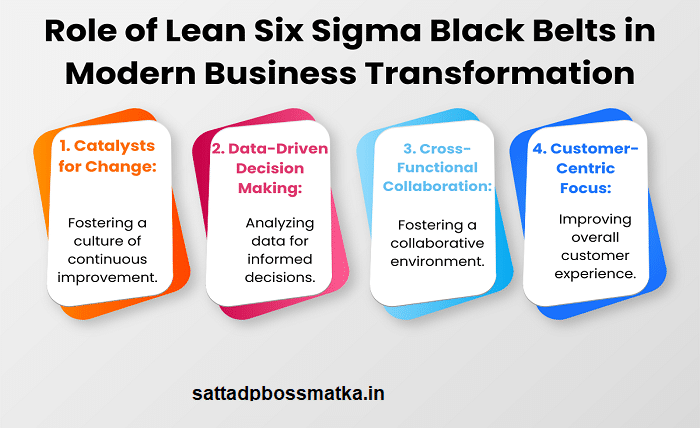
The Role of Six Sigma Black Belts in Organizational Transformation
In a time of swift technological progress, shifting consumer demands, and unpredictable market environments, organizational change has turned into a critical need for companies hoping to survive in a cutthroat market. The expertise and leadership of Six Sigma Black Belts, individuals with the knowledge, abilities, and vision to create significant change, promote continuous improvement, and lead their businesses towards long-term success, are at the center of this transformation path. In-depth analysis of the critical role lean Six Sigma Black Belts play in organizational change and the reasons they are essential catalysts for quality, efficiency, and innovation is provided in this thorough investigation.
A. Comprehending Organizational Change
A complex process of renewal, adaptation, and reinvention, organizational transformation aims to align systems, structures, and strategies to meet changing company needs and grab new possibilities. Organizations go on transformation journeys to improve competitiveness, spur development, and future-proof their operations in a world that is changing quickly. These journeys range from digital transformation efforts to cultural upheavals and strategic realignments. Organizational transformation fundamentally necessitates a comprehensive strategy that takes into account people, processes, and technologies, all while maintaining a laser-like focus on creating value, encouraging innovation, and providing exceptional customer experiences.
B. Six Sigma’s Development Black Belts as Agents of Change
Six Sigma Black Belts are essential change agents in the field of organizational transformation. They lead programs to maximize efficiency, eliminate waste, and optimize processes while helping organizations through the intricacies of change. Equipped with a profound comprehension of Six Sigma methodologies, sophisticated statistical instruments, and optimal project management techniques, Black Belts function as stimulants for ongoing enhancement, producing quantifiable outcomes, and cultivating an exceptional culture within their establishments.
The Crucial Function of Six Sigma Black Belts in Strategic Alignment and Visionary Leadership for Organizational Transformation: Six Sigma When it comes to converting organizational vision and strategic priorities into concrete projects with quantifiable results, Black Belts are essential. Black Belts make sure that transformation initiatives are strategically aligned, value-driven, and concentrated on producing measurable business advantages by matching Six Sigma projects with broad business objectives.
Process Optimization and Data-Driven Decision-Making: Six Sigma is based on a dedication to process optimization and data-driven decision-making. Black Belts apply process mapping methodology, sophisticated statistical analysis, and root cause analysis techniques to find inefficiencies, diagnose underlying causes, and implement focused solutions that lead to long-lasting gains in productivity, quality, and performance.
Cross-Functional Collaboration and Stakeholder Engagement: Cooperation, coordination, and alignment between various functional areas and stakeholder groups are necessary for an organization to transition successfully. By uniting cross-functional teams, encouraging cooperation, and cultivating a feeling of shared accountability and ownership for transformation projects, Black Belts act as bridge builders.
Change Management and Cultural Transformation: Promoting change management and cultural transformation within their organizations is arguably one of the most important responsibilities of Six Sigma Black Belts. Through the promotion of an innovative mindset, a culture of continuous development, and an attitude of resilience and flexibility, Black Belts enable staff members at all levels to welcome change, overcome obstacles, and propel group success.
Continuous Learning and Improvement: Organizational transformation is a lifelong process of learning and continuous improvement rather than a single event. This philosophy of lifelong learning is embodied by Black Belts, who are always looking for ways to better their abilities, broaden their knowledge, and keep up with the latest developments and industry best practices in organizational excellence, process optimization, and quality management.
C. Examples of Six Sigma Black Belt Success Stories in the Real World
Six Sigma Black Belts have been crucial in fostering organizational change and producing quantifiable outcomes in a variety of fields and businesses. Think about these actual instances from real life:
- Manufacturing: By implementing process controls and quality improvement activities, a Six Sigma Black Belt led a cross-functional team in a big automotive manufacturing company to cut production defects by forty percent.
- Healthcare: A Black Belt initiative that streamlined patient discharge procedures in a hospital context led to a thirty percent decrease in discharge times, which enhanced patient satisfaction and operational effectiveness.
- Finance: A Black Belt project to streamline loan processing workflows in a financial services company led to a 50% decrease in cycle times as well as a notable increase in client satisfaction and response times.
- Technology: A Black Belt initiative aimed at streamlining software testing procedures in a software development company resulted in a twenty percent increase in overall product quality and a twenty percent decrease in defects, which raised customer satisfaction and increased software reliability.
D. The Significance of Six Sigma Black Belts in Strategy
Apart from their tactical responsibilities of promoting operational efficiency and process enhancements, Six Sigma Black Belts hold substantial strategic sway in their companies. Black Belts contribute to long-term value generation and assist determine the future course of their organizations by coordinating Six Sigma projects with organizational priorities and more general strategic goals. In an ever-changing market, Black Belts use their experience to solve strategic problems and seize new opportunities, whether it’s cutting the time to market for new products, improving customer happiness, or streamlining supply chain operations.
In addition, Six Sigma Black Belts challenge the status quo and promote an environment of experimentation and ongoing learning by acting as catalysts for innovation and organizational agility. Black Belts create breakthrough discoveries, build resilience, and inspire creativity in others by their unwavering pursuit of excellence and willingness to question conventional wisdom. These attributes help their organizations achieve new heights of success.
E. Strengthening Institutions for the Future
In order to maintain organizational resilience, adaptability, and competitiveness, Six Sigma Black Belts play a crucial role as the rate of change quickens and the complexity of business environments increases. Black Belts give their firms the tools, processes, and attitude necessary to accept change and negotiate uncertainty. This allows their businesses to prosper in a world characterized by disruption, transformation, and opportunity.
In summary, utilizing Six Sigma Black Belts to drive organizational change
To sum up, Six Sigma Black Belts play a special and vital role in promoting organizational change and a continuous improvement, innovation, and excellence culture. The knowledge, vision, and leadership of Six Sigma Black Belts act as guiding lights for businesses as they negotiate the challenges of a quickly evolving business environment. They show the way to operational excellence, competitive advantage, and long-term success. Organizations can fully utilize their people, processes, and technology and prosper in an era of unparalleled change and opportunity by adopting the Six Sigma principles, empowering their teams, and promoting a continuous improvement culture.




